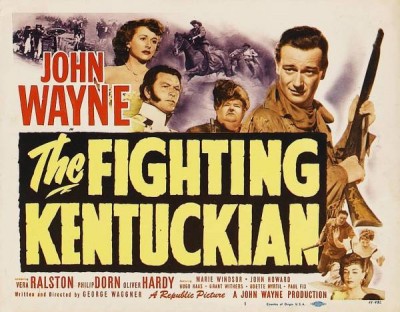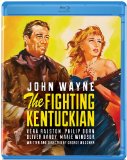| Reviews & Columns |
|
Reviews DVD TV on DVD Blu-ray 4K UHD International DVDs In Theaters Reviews by Studio Video Games Features Collector Series DVDs Easter Egg Database Interviews DVD Talk Radio Feature Articles Columns Anime Talk DVD Savant Horror DVDs The M.O.D. Squad Art House HD Talk Silent DVD
|
DVD Talk Forum |
|
|
| Resources |
|
DVD Price Search Customer Service #'s RCE Info Links |
|
Columns
|
|
|
Fighting Kentuckian, The
What makes The Fighting Kentuckian interesting to watch these days has little to do with Wayne. Rather, it's the actor playing his sidekick, an inspired break from the usual Walter Brennan-"Gabby" Hayes-type old-timer. This time the sidekick is played by none other than Oliver "Babe" Hardy of the beloved comedy team of Laurel & Hardy. As a duo, Laurel & Hardy had since 1926 been steadily employed starring in films for Hal Roach, and later at both MGM and Fox. But Hollywood had seemingly lost interest in the pair and though various starring projects and guest appearances in other people's films were discussed, they made no more American films at all after 1945. Hardy was initially reluctant to accept Wayne's offer to appear in The Fighting Kentuckian, fearing moviegoers would think he and Stan Laurel had split up, but his delighted partner encouraged Babe to take the role.
For Laurel & Hardy aficionados, Hardy's work in The Fighting Kentuckian fascinates. Here he's emphatically not playing the Ollie character of his films with Stan, though it is a comedy relief part, and little bits and pieces of his more familiar screen persona slip through. But he's also clearly playing somebody else, an early 18th century southerner, laid-back, friendly, and a conspicuous consumer of good food and rum.
I owned Artisan's DVD of The Fighting Kentuckian for something like ten years but never watched it, mainly because the transfer was extremely poor, nearly public domain quality. Conversely, Olive's high-def video transfer of this Paramount-licensed title is nearly perfect and a real pleasure to watch.
The movie is set entirely in Alabama circa 1818, first in Mobile then for the remainder of the film in Demopolis, a city founded by Bonapartists, French exiles granted four townships of territory by the U.S. Government following Napoleon's defeat at Waterloo.
The movie is composed to two interrelated plots. In the first, rugged Kentucky rifleman John Breen (John Wayne), after a meet-cute introduction, falls for Fleurette (Vera Ralston, the girlfriend and later wife of studio head Herbert Yates), the daughter of French ex-general De Marchand (Hugo Haas). But Fleurette is already engaged to wealthy Blake Randolph (John Howard), who holds a monopoly on the state's riverboat system, and Pvt. Breen's lowly social status deems him ineligible in any case.
Randolph is himself peripherally involved in a land-grab scheme with George Hayden (Grant Withers), who in turn has two confederates, Beau Merritt (Paul Fix) and tavern singer Ann Logan (Marie Windsor). They've secretly moved stakes for land the French have unwittingly developed, unaware that Hayden very soon plans to seize for himself.
With the kind of set-up that Wayne always seemed to like and used again and again in his films, Breen and his unassuming, rowdy, and hard-drinking fighting Kentuckians square off against the elegantly attired, sophisticated but pretentious rivals, resulting in several mass brawls. It's also a foregone conclusion that Fleurette will fall head-over-heels in love with brash frontiersman Breen and never marry stuffed shirt Randolph.
The unusual setting rather than the story provides some interest. Comparatively few Hollywood movies have been set between the end of the Revolutionary War and start of the Civil War, and even less in the first quarter of the 19th century. The fact-based story of the Bonapartists was all but unknown to this reviewer and history buff, so that angle intrigues.
But the main reason to watch the film today is for Oliver Hardy. Apparently he was cast after he and Wayne spent time touring a charity stage production of What Price Glory?, though Hardy was so sociable and well-liked in Hollywood he probably received offers like this all the time. During the silent era, before he teamed with Stan, Babe had been a famously versatile character comedian who occasionally tackled dramatic roles. Unlike Stan, who honed his craft in British music halls, Babe learned his as a film actor from the start. He quickly figured out how to play to the camera and was so good and subtle at what he did the bigger stars he supported sometimes were jealous of his great skill.
The Fighting Kentuckian leaves no doubt that, without Stan, Babe would have gotten along just fine in character parts. Laurel & Hardy historian Randy Skretvedt favorably likens his performance to Edgar Buchanan, but to me Hardy's Willie Payne plays more like the kind of characterizations (if a bit less sophisticated) often played by fellow Georgia native Charles Coburn. (It's not clear to me whether Babe allows himself to fall back on his Harlem, Georgia accent or is attempting a specifically Kentuckian one, but it's a further subtle break from his Ollie character.)
He gives a warm rather than broadly comic performance. One especially good example of this is a fine scene where Willie generously offers Breen the loan of his beloved beaver skin hat, a family heirloom once belonging to Daniel Boone, to help spruce up the courting Breen. It's a sweet little scene, partly because it reflects Babe's real-life kindness and generosity. A couple of times Babe allows bits of Ollie to slip through, notably in the film's final gag, where Willie falls on his bugle, his giant butt flattening it like a pancake. Willie's expression of exasperation comes closest to the more familiar Ollie, and it's a good old-fashioned laugh.
The rest of the picture is the same old-same old, though not unpleasant. By B-studio Republic standards it's pretty lavish, and occasionally amusing. One of Wayne's later trademarks was an exaggerated right hook, pulling his big fist a good three feet behind him before swinging it back around and connecting it with some bad guy's jaw. In The Fighting Kentuckian, an amusing camera angle photographs this in such a way that when Wayne's fist is all the way back it almost connects with the camera lens.
Video & Audio
As with other John Wayne-Republic titles handled by Olive Films, The Fighting Kentuckian looks great. Title elements and dissolves are notably dupey, but generally the blacks are rich and the picture, at times, razor-sharp. The DTS-HD Master Audio, in its original mono, English only with no subtitle options, is also excellent. No Extra Features.
Parting Thoughts
A pretty good John Wayne movie but a must-see for Oliver Hardy fans, The Fighting Kentuckian is Highly Recommended.
Stuart Galbraith IV is a Kyoto-based film historian whose work includes film history books, DVD and Blu-ray audio commentaries and special features. Visit Stuart's Cine Blogarama here.
|
| Popular Reviews |
| Sponsored Links |
|
|
| Sponsored Links |
|
|
| Release List | Reviews | Shop | Newsletter | Forum | DVD Giveaways | Blu-Ray | Advertise |
|
Copyright 2024 DVDTalk.com All Rights Reserved. Legal Info, Privacy Policy, Terms of Use,
Manage Preferences,
Your Privacy Choices | |||||||















